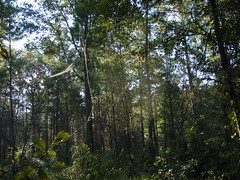 The state of Georgia already finances a
Conservation Reserve Program (CRP)
to plant longleaf pines with
associated native ground cover (partridge pea that the quail like,
and bunch grasses such as wiregrass that help fuel periodic fires).
The state of Georgia already finances a
Conservation Reserve Program (CRP)
to plant longleaf pines with
associated native ground cover (partridge pea that the quail like,
and bunch grasses such as wiregrass that help fuel periodic fires).
However, CRP payments typically only last 10 years and not more than 15 years, and such trees usually eventually get cut for sawtimber or pulpwood. Now that’s better than cotton: much less pollution involved and far more carbon sequestered.
But even better would be to treat such replanting as real reforestration and sell carbon sequestration rights for such forests. Like what is being planned in Florida:
At a recent conference, sponsored by the Florida Wildlife Federation, Environmental Defense and Tall Timbers Research Station, noted economist Zach Willey brought what he thinks is a new source of income to local farmers and those who own tracts of land in timber.
…
Willey said using large tracts of forested land that naturally transform carbon dioxide into oxygen may come to be a $100 million industry in Florida. Energy companies would reimburse property owners based on the amount of carbon dioxide their land can absorb.
And like what is already being done in California:
This website is also a demonstration of how to implement a certification of sequestered carbon with the California Climate Action Registry using the Forest Project Protocol. A Forest Project Protocol certifies a portion of a forest as opposed to the whole property. The demonstration site is located in LaTour Demonstration State Forest, northeast of Redding, California.
Remember, the jobs are in the trees. Not only can reforestration be for profit, in addition carbon sequestration can apply to existing forests.
Short Link: